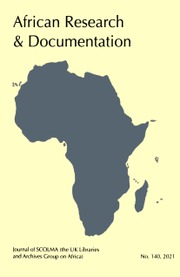Article contents
The Colonial Archive as Material Remains: Reflections on an “Endangered Archives Project”
Published online by Cambridge University Press: 25 April 2022
Extract
Between January and April 2016,1 was part of a British Library-funded project to restore, preserve, and digitise the archive of the Presbyterian Church of East Africa (PCEA). The archive is held in a small room in the bell tower of St. Andrews church, Nairobi. The collection consists of the records of the colonialera Church of Scotland Mission (CSM) and its successor institution, the PCEA, which was formed in 1956 when the African church became independent from the Scottish mission. When I first accessed it, it was being used by the church as a place to store and dump all sorts of miscellaneous and unneeded objects. As well as the heaps of papers, it contained an old lectern, posters, brochures, parish leaflets, and general rubbish. Depending on one's perspective it could have been seen as not much of an “archive”, or much more than one.
Information
- Type
- Research Article
- Information
- Copyright
- Copyright © International African Institute 2017
References
Notes
1 A growing body of literature problematises the archive itself. In addition to the endnotes see: Antoinette Burton, Archive stories: facts, fictions, and the writing of history. Durham, NC, Duke University Press, 2006; Ann Laura Stoler, Along the archival grain: epistemic anxieties and colonial common sense. Princeton, NJ, Princeton University Press, 2010.
2 This term is taken from Ally, Shireen, ‘Material remains: artifice versus artefact(s) in the Archive of Bantustan Rule’, Journal of Southern African studies, 41, 2015, pp. 969-989. Ally's insights have been instrumental in my thinking on the PCEA archive. I am grateful to Joost Fontein for directing me to this text and for our many discussions about the archive.
3 Kenya, 1898-1948: The Jubilee Book of the Church of Scotland Mission Kenya Colony (Edinburgh: The Committee, 1948).
4 David M. Anderson, “Master and Servant in Colonial Kenya, 1895-1939,” Journal of African history 41(3) 2000, pp. 459-85.
5 For this topic, see Derek Raymond Peterson ‘Writing Gikuyu Christian Literacy and Ethnic Debate in Northern Central Kenya, 1908-1952’ (Unpublished PhD thesis, Minnesota, 2000) and the later publication Derek R. Peterson, Creative writing: translation, bookkeeping, and the work of imagination in colonial Kenya. Portsmouth, NH: Heinemann, 2004.
6 Quotation attributed to Kenyatta in Jeremy Murray-Brown, Kenyatta. London: Allen and Unwin, 1972.
7 See Church of Scotland, Memorandum prepared by the Kikuyu Mission Council on female circumcision, 1 December 1931.
8 A copy of the address is printed in Ngugi wa Thiong'o. Homecoming: essays on African and Caribbean literature, culture and politics. London: Heinemann, 1972, under the title “Church, culture and politics”, pp. 31-36.
9 A transcript can be found in PCEA I Series II, Box C60, Ngugi wa Thiong'o “The role of the church in Africa today”, “General Assembly Reports and Resolutions, ”Proceedings of the Sixth General Assembly, March 1970.
10 Antoinette M Burton, Archive stories: facts, fictions, and the writing of history. Durham, NC, Duke University Press, 2005, p.6
11 Ibid. 9. See also Achille Mbembe “The power of the archive and its limits” in refiguring the archive, ed. Carolyn Hamilton et al. Dordrecht, Kluwer, 2002, pp. 19-27.
12 Liam Buckley ‘Objects of love and decay: colonial photographs in a postcolonial archive', Cultural anthropology, 20,2005, pp.249-70.
13 I do not think there was anything “important” in the wooden box that was burned. Mostly it consisted of multiple copies of glossy brochures advertising the luxury apartments built by the PCEA in 2015. Shoved into the corner of the room, it certainly would have looked like rubbish.
14 Ime Ikiddeh, “Foreword” to Ngugl wa Thiong'o, Homecoming: essays on African and Caribbean literature, culture and politics. London: Heinemann, 1972, pp. xi-xiv.
- 1
- Cited by

